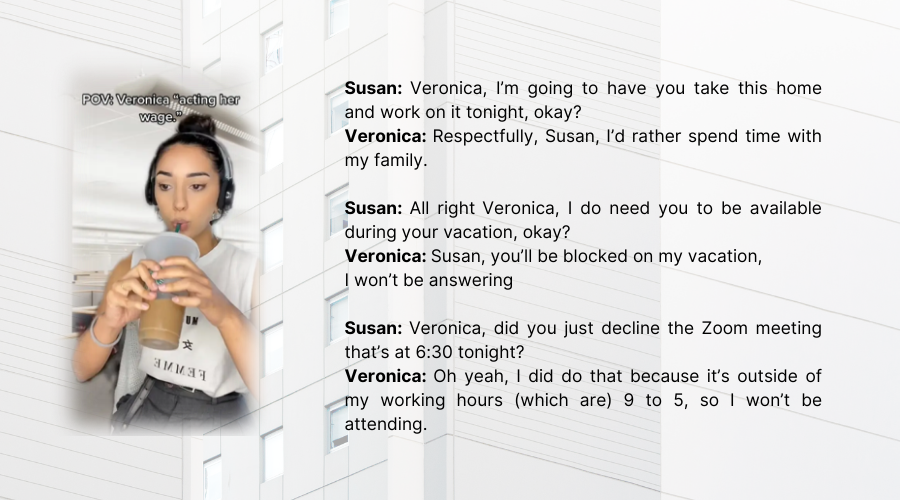Qué es el Quiet Quitting y cómo evitarlo
Aprenda qué es el abandono silencioso con nuestra guía completa. Reconoce sus primeros síntomas, las formas de evitar que se apodere de ti y cómo superarlo.
En esta página
It started with a 17-second video by Zaid Khan (@zaidlepplin), where he described a concept that resonated with millions: doing your job—no more, no less.
This viral moment gave rise to a workplace phenomenon now known as quiet quitting. Shortly after, TikToker Sarai Marie (@saraisthreads) amplified the trend with relatable skits, spotlighting employees silently stepping back from hustle culture.

So, what is quiet quitting exactly? It’s not about resigning—rather, it's the conscious decision to stop going above and beyond at work, choosing instead to meet expectations without overextending. While some see it as reclaiming work-life balance, for employers, it’s a red flag of disengagement.
According to Gallup study, disengaged employees cost businesses $7.8 trillion in lost productivity globally. Clearly, this is more than a social media trend—it’s a wake-up call.
In this blog, we explore what’s driving quiet quitting, its impact, and most importantly, how to avoid quiet quitting in your organization through empathy, communication, and smart engagement strategies.
What is quiet quitting?
Aunque hay varias interpretaciones del término "renuncia silenciosa", en general significa abandonar la cultura del ajetreo con su debilitante presión laboral y sus largas horas de trabajo. Se refiere a hacer sólo lo mínimo en el trabajo en lugar de ir "más allá" para impresionar a los jefes y avanzar en sus carreras.
El aumento casi meteórico de la popularidad del "Quiet quit" puede atribuirse a la pandemia y a un entorno laboral radicalmente cambiante. El trabajo a distancia difuminó los límites entre el hogar y la oficina, y la gente empezó a cuestionar la necesidad de priorizar el trabajo en detrimento de la familia y la vida personal. Los debates activos en las redes sociales giraron en torno al impacto del agotamiento en la vida mental, física y social, ya que cada vez más trabajadores comenzaron a rechazar la noción de la cultura de vivir para trabajar.
Ahora, mientras las empresas luchan por volver a la normalidad en medio de una batalla campal por el mantenimiento del trabajo a distancia, muchos empleados están reevaluando cómo viven, cómo pasan su tiempo y qué es importante en sus trabajos. El movimiento "quiet quitting" allana el camino para establecer límites saludables en el trabajo, eliminar el agotamiento y renegociar un equilibrio más saludable entre la vida laboral y la personal.
Stories about quiet quitting
Internet está lleno de personas que abandonan su trabajo. No son sólo los obreros, sino que incluso los ejecutivos han empezado a contar sus propias historias de abandono silencioso después de luchar contra el deterioro de la salud mental, la inexistente vida social y la exigente tarea de equilibrar el trabajo y la familia. Algunos, tras haber perdido a sus seres queridos a causa de la pandemia, se dieron cuenta de que se habían perdido momentos cruciales de la vida debido a la abrumadora presión del trabajo. Otros se mostraron elocuentes sobre la posibilidad de reconectar, rejuvenecer y reponer fuerzas.
Si bien estas historias dibujan un panorama más amplio, ¿qué aspecto tiene el abandono silencioso sobre el terreno?

The economics of quiet quitting
Los informes muestran que no se trata de casos aislados; al menos la mitad de la Generación Z' en Estados Unidos (y otros a nivel mundial) se retrae mental y emocionalmente ante sus exigentes cargas de trabajo y sus jefes poco empáticos.
Maria Kordowicz, profesora asociada y directora del centro para la educación y el aprendizaje interprofesional de la Universidad de Nottingham, traza la relación entre el abandono silencioso y el aumento simultáneo de las renuncias al trabajo, vinculando el fenómeno a un notable descenso del compromiso.
El informe mundial sobre el lugar de trabajo de Gallup para 2022 atribuye esta oleada de renuncias al aumento de una nueva clase de empleados "empoderados" que están liderando la conversación sobre cómo la responsabilidad debe recaer en los empleadores para eliminar la causa principal del agotamiento. El último estudio de HBR sobre el impacto de los directivos en el abandono silencioso lo corrobora al mostrar cómo el entorno de trabajo y las capacidades de liderazgo son factores clave para mover la aguja hacia la productividad o la desvinculación.
Por último, el Secretario de Trabajo de EE.UU. , Marty Walsh, se refiere a las repercusiones económicas inmediatas del abandono del trabajo en silencio y señala que los datos del gobierno estadounidense muestran un sorprendente descenso de la productividad laboral en EE.UU. este año. Dice: "Si eres empresario, deberías darte cuenta lo bastante pronto de que tus empleados no están satisfechos, no están contentos, y entonces tiene que haber un diálogo, una conversación".
Top 5 signs to look for in quiet quitting
‘Quiet quitting’ captures the spirit of the ‘new normal’—a time when more employees are choosing to do just enough to get by, rather than going above and beyond. While it may not seem like a pressing issue at first glance, this silent form of disengagement can have a compounding effect on team morale, productivity, and ultimately, business performance.
As employee motivation dips, so does innovation and customer experience—affecting both revenue generation and ROI. Here are the top five warning signs to help managers spot quiet quitting before it impacts the bottom line:
1. Chronic disengagement
Employees who were once enthusiastic but now display ongoing disinterest or apathy are waving a red flag. This lack of motivation often stems from burnout, feeling undervalued, or disconnected from their work. They may meet deadlines, but their energy, passion, and initiative are noticeably absent.
2. Only meeting minimum expectations
Quiet quitters fulfill their basic responsibilities—but that’s it. They no longer seek to exceed expectations or take ownership beyond their immediate duties. Unlike highly engaged employees who find purpose in their roles, quiet quitters work purely transactionally, often lacking pride in their performance.
3. Avoidance of extra tasks or initiatives
One of the most telling signs is an employee’s reluctance to take on anything that falls outside their job description. Whether it’s volunteering for new projects, mentoring a colleague, or attending optional trainings, quiet quitters will quietly decline—signaling a shift away from organizational commitment.
4. Isolation from the team
Collaboration is often the first to suffer. Quiet quitters may avoid brainstorming sessions, team-building activities, or cross-functional projects. They tend to prefer working in isolation, limiting interaction to what’s strictly necessary—weakening team cohesion and trust.
5. Minimal engagement in meetings
Rather than being active contributors, quiet quitters often remain silent during meetings. They may show up but rarely speak, contribute ideas, or provide feedback. This disengagement can slowly erode the overall team dynamic and innovation pipeline.
By recognizing these behaviors early, leaders can proactively re-engage employees through open dialogue, personalized support, and a culture that values work-life balance and meaningful contribution. Preventing quiet quitting isn’t just about productivity—it’s about preserving the heart of your organization.
Contrasting views on quiet uitting
Las preguntas sobre los pros y los contras de la estrategia del "quiet quitting" continuarán sin duda alguna. Pero el "quiet quitting" es real y está aquí para quedarse hasta que las empresas se decidan a hacer un cambio ilustrado para detener el agotamiento ofreciendo salarios justos y tomando medidas para comprometer, desafiar y estimular a sus empleados.
Sin embargo, no todo el mundo está de acuerdo con el nuevo concepto. Algunos detractores afirman que los que renuncian en silencio se cierran a los aumentos de sueldo y a los ascensos porque siempre habrá alguien que ocupe su lugar.
Partidarios
Since COVID, my priorities, values, who and what are important to me have shifted drastically. I now leave my office at the end of the day, not thinking about what I need to work on when I go home at night. I set boundaries for checking my emails and reaching out to co-workers during non-office hours. Most importantly, I am not anxious when requesting time off, taking personal days, or especially taking sick time. Before, it was something I would agonize over, and now it is something I can do without hesitation or worry.” Sara M., department manager
"Many of my friends work in Big Law, and while they're paid very well, the expectations placed on Associates are extremely demanding and often unfair/emotionally abusive. They can't or won't draw similar boundaries, often for fear of retaliation, but they all recognize the toll it takes on their mental and physical health. Many have left their positions as a result." Lane Sheldon, attorney
Detractores
“I have zero ability to do anything but do as my boss requires me. The idea that 'quiet quitting' fits any job besides the ones laden with keyboard strokes, spreadsheets, and meetings, is foolish. It feels like more of a realization by people, who were more than happy to work 24/7/365 chasing the almighty dollar, that their lives are wasted in pursuing more stuff. Now they are presenting some laughable notion of 'I just realized I work too much, but luckily I can afford to do less because no one will notice anyway!' as a paradigm shift in worker's rights. I am disgusted that this has become something people believe could be effective for most of the workforce.” James Holverstott, laborer
“Quiet quitting is doing the bare minimum required of you at work and being content with mediocrity. Advancement and pay increases will go to those whose level of effort warrants advancement and doing the bare minimum certainly does not." Pattie Ehsaei, workplace decorum expert
How to solve the quiet quitting crisis in 2025
Esta afirmación de Gallup pone de relieve la causa fundamental de la crisis del abandono de los puestos de trabajo: el compromiso de los empleados. No se trata tanto de que los trabajadores se desentiendan de su trabajo como de que pongan límites porque no se sienten valorados o apreciados en sus respectivas organizaciones.
He aquí algunas cosas que pueden ayudar tanto al empresario como al empleado a crear una relación significativa y equilibrada para evitar el abandono silencioso.
1. Haz que hablen y prepárate para escuchar
Habla con tus empleados y profundiza para averiguar sus motivos para quedarse callados. Haz preguntas relevantes sobre su carga de trabajo y su ancho de banda, y determina si están satisfechos con sus tareas/proyectos actuales o necesitan recursos o aprendizaje adicionales.
- Abra un canal de comunicación bidireccional.
- Pida opiniones sinceras sobre la empresa y el liderazgo.
- Cree un entorno en el que sus empleados se sientan cómodos hablando.
- Proporcionar una motivación y una estimulación constantes.
- Acepte los comentarios y actúe en consecuencia para aplicar los cambios.
2. Equilibrar el rendimiento y las expectativas
Siéntese y evalúe la carga de trabajo de sus empleados, mantenga conversaciones significativas sobre los objetivos de rendimiento y reevalúe las expectativas de la empresa y cómo puede ayudar a equilibrar ambas cosas. Establezca los límites adecuados entre la vida personal y el trabajo.
- Mantener reuniones 1 a 1 sobre los objetivos de rendimiento y cómo alinearlos con la visión superior de la empresa.
- Fomente un equilibrio saludable entre el trabajo y la vida privada con conversaciones sobre la salud mental.
- Anime a sus empleados a tomarse tiempo libre para recargar y descansar cuando estén enfermos para evitar el agotamiento.
- Asegúrese de que sus empleados tienen el tiempo y los recursos adecuados para completar sus tareas.
- Averigüe si hay bloqueos y cómo eliminarlos/trabajar en torno a ellos para mantener altos niveles de productividad.
- Permita a sus empleados trabajar de forma autónoma y utilizar diferentes habilidades para mantener su entusiasmo.
- Promover el desarrollo y la progresión de la carrera interna.
3. Reward and recognize
Employees thrive on motivation and recognition. It’s essential to frequently appreciate your employees—not just for exceeding expectations, but also for consistently meeting them. Recognition should be timely, personalized, and meaningful.
With Empuls, you can move beyond annual award ceremonies and create an ongoing, immersive rewards and recognition experience that keeps employees engaged throughout the year. The platform enables:
- Personalized appreciation through social shout-outs, core value badges, and peer-to-peer recognition.
- Multiple types of awards—spot, nomination-based, jury awards, milestone celebrations, and service anniversaries—automated and easy to manage.
- A global rewards catalog offering gift cards, experiences, wellness options, and company swag across 100+ countries.
- Integration with popular work tools, so recognition happens seamlessly in the flow of work.
Pair this with a competitive compensation structure and a benefits package supporting physical, psychological, and financial wellness—and you’re well on your way to building a culture where employees feel seen, valued, and inspired to stay.
4. Create a culture of belonging and connection
Disengagement often stems from feeling disconnected from the organization’s purpose or values. Fostering a strong sense of community can make employees feel seen, heard, and appreciated—not just for what they do, but for who they are.
- Build community spaces using platforms like Empuls, where employees can join interest-based groups, celebrate milestones, and engage in informal conversations.
- Use town halls and internal social feeds to regularly communicate company wins and vision updates.
- Celebrate life events—like birthdays, work anniversaries, or team wins—to promote a culture of shared success.
- Encourage informal moments like virtual coffee chats or hobby clubs to humanize the workplace.
5. Actively seek and respond to feedback
Quiet quitting can also result from employees believing their opinions don’t matter. Regular employee feedback loops—when handled well—can be a game changer in re-engaging a disillusioned workforce.
- Use Empuls’ survey and feedback tools to run pulse checks, eNPS, and lifecycle surveys that capture real-time employee sentiment.
- Analyze feedback through people analytics and take action with data-backed insights.
- Close the loop by communicating what changes were made based on employee input—this builds trust and reinforces their voice in decision-making.
- Don’t limit feedback to exit interviews; start from onboarding and keep it continuous.
6. Make Wellbeing a Priority, Not a Perk
In a world where burnout is a leading cause of disengagement, organizations must go beyond token wellness days. Employees want holistic, ongoing support for their physical, mental, and financial wellbeing.
- Offer personalized perks and benefits through Empuls’ Perks & Benefits module, including early wage access, tax-saving allowances, wellness subscriptions, and more.
- Promote flexibility—whether it's hybrid work, asynchronous schedules, or mental health days.
- Equip managers with tools to regularly check in on employee well-being, using smart nudges from Empuls’ AI assistant, Em, to guide conversations.
- Encourage usage of benefits by showcasing real stories from employees who’ve found them helpful.
By combining empathetic leadership with the right tools, organizations can shift from simply preventing quiet quitting to cultivating an energized, loyal, and purpose-driven workforce. Platforms like Empuls enable this transformation by integrating communication, recognition, feedback, and wellbeing into a unified employee engagement strategy.
Conclusion: From quiet quitting to active engagement
Quiet quitting isn’t about laziness—it’s a signal. A signal that employees are craving more balance, purpose, and recognition in the workplace. It’s a response to burnout, misalignment, and a lack of meaningful connection—not a rebellion against work itself.
Organizations that want to reverse this trend must rethink how they engage, support, and value their people. Open communication, fair expectations, regular recognition, and a genuine investment in employee wellbeing can turn quiet quitters into active contributors.
Tools like Empuls make this transformation easier by empowering HR and managers to listen actively, reward meaningfully, and build an inclusive culture of belonging. The result? A motivated workforce that’s not just meeting expectations—but thriving well beyond them.
Now is the time to shift from reactive to proactive. Because when employees feel valued, they don’t quit quietly—they show up loudly. And they stay.











